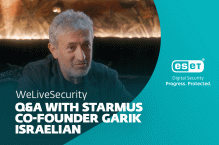While the defining research on the Stuxnet topic doesn’t go this far, Forbes writer Trevor Butterworth went out on a limb to name names along with detailing the warfare aspects:
- As I noted last week – and as the news media have only begun to grasp – Stuxnet represents a conceptual change in the history of warfare, the ability to launch fire-and-forget cyber weapons against physical targets and cause them to malfunction.
In the previous article Trevor mentioned:
- The very prospect that Israel – or whomever – could shut down Iran by destroying its electrical grid through causing every generator to overload in a matter of minutes is a powerful signal: the signal that cyber war has physical consequences that make conventional air strikes look quaint and maladroit, so 20th century.
However, right now with the available information we have at ESET, attribution is still not defined. One should be very careful not to attempt to label any nation state with attribution of a cyber attack.
See SC Magazine Article: Leading Stuxnet theory points toward sabotage and SCADA inside players
In fact, in many of our articles we’ve said that unclear attribution is what makes cyberwarfare so darned attractive. From the ‘Barbarians at the Gates’ section of my previous article about Cyberwarfare’s complications two warnings are being validated:
- From this amateur military historian’s perspective, throughout human history we tend to simply not value the severity of a threat. Also, the impact of powerful deceptive cyberwarfare operations shouldn’t be underestimated – Georgia v. Russia won’t be the last time it’s used.
Stuxnet Expert Opinion: ESET’s David Harley
There is a Stuxnet white paper available right now written by ESET’s David Harley and the ESET Russia team which answers several questions about Stuxnet’s purpose, whether it was really aimed at Iran, and key indicators of malware authorship.
As for Cyberwarfare, there are three questions we answered six months before any of this happened: How it would look, how it would work legally, and how we can defend against it.
How would cyberwarfare look?
- Cyberwarfare and Music: It’s All Tempo
- 21st Century Hunter-Killer UAV Enters Restricted DC Airspace – Skynet Alive?
- Bricking your cell phone: Mayhem on a Massive Scale
- What HILFs mean to Critical Infrastructure: Stuxnet and Beyond
- Malware Injection Campaign: A Retaliation?
- Cybercrime and Cyberwarfare: Warnings Unheeded?
- Cyberwar Exposed
- Previously classified: malware's role in Pentagon attack
What would the Rules of Engagement set by the President define?
- Cyberwarfare and Music: It’s All Tempo
- From Megatons to Megapings: Cyberwarfare
- Kinetic Warfare vs. Cyberwarfare
How can countries and commercial interests both defend against this threat?
- From Megatons to Megapings: Cyberwarfare
- Operation Cyber ShockWave
- HR 4061: What Three Bucks buys you…
- What you can learn from Stuxnet
- Learn Seven Ways To Keep HILFS From Crashing Your Party
- What HILFs mean to Critical Infrastructure: Stuxnet and Beyond
- Securing our eCity: Grassroots block-by-block cyber threat awareness




